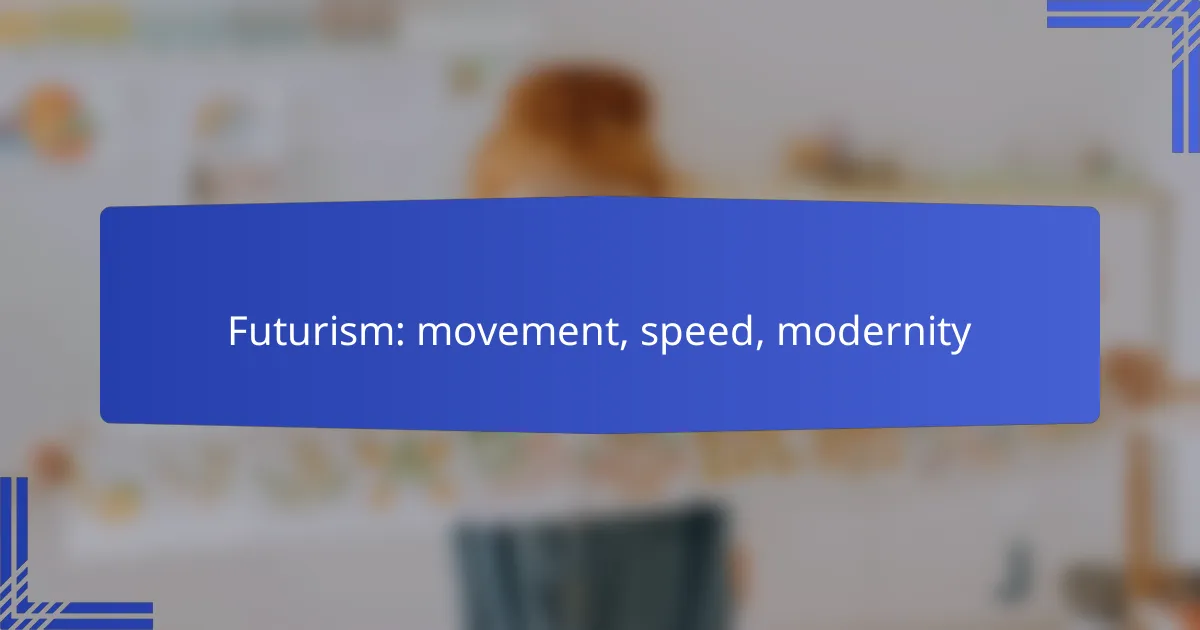Futurism is a revolutionary movement that celebrates speed, technology, and modernity, fundamentally transforming the landscape of art and design. By embracing the dynamism of urban life and industrial progress, it encourages contemporary artists to break away from traditional forms and explore innovative expressions. This emphasis on modernity continues to inspire creative endeavors, shaping the way we perceive and interact with the world around us.
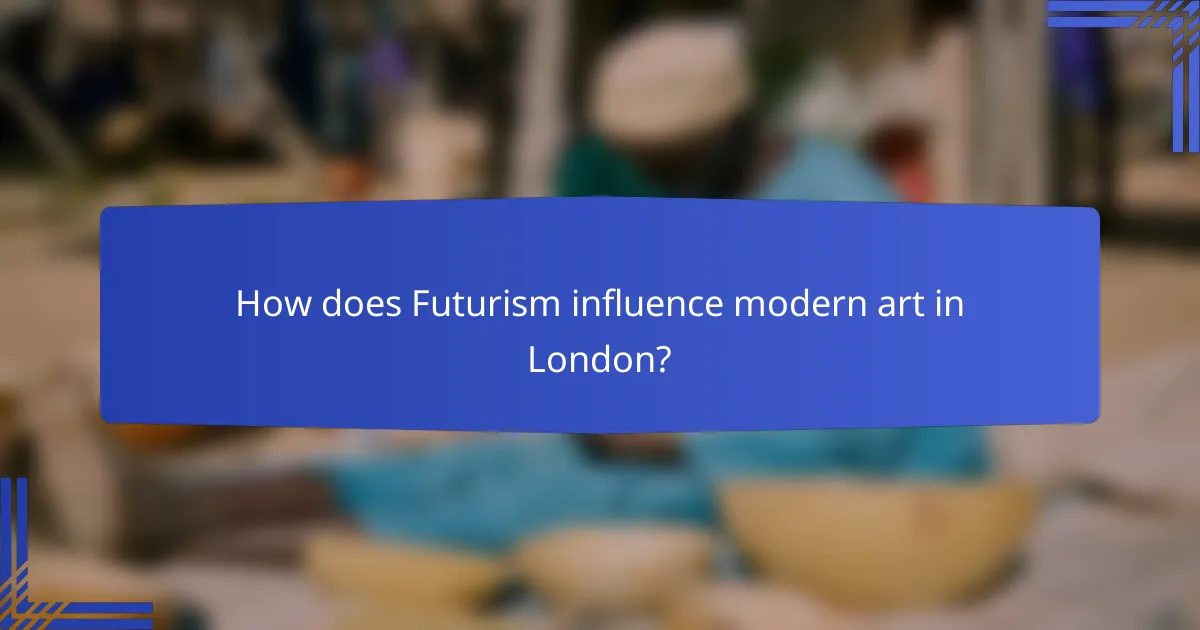
How does Futurism influence modern art in London?
Futurism significantly impacts modern art in London by emphasizing speed, technology, and dynamic movement. This movement inspires contemporary artists to explore themes of modernity and innovation, often incorporating elements of urban life into their work.
Impact on contemporary artists
Contemporary artists in London draw from Futurism’s core principles, using bold colors and dynamic forms to convey motion and energy. Artists like Ben Eine and Banksy have incorporated these themes into street art, reflecting the fast-paced urban environment.
Additionally, the influence of Futurism can be seen in digital art, where artists experiment with technology to create immersive experiences that challenge traditional notions of art. This blend of technology and creativity continues to push the boundaries of modern artistic expression.
Exhibitions showcasing Futurism
London hosts several exhibitions that celebrate the legacy of Futurism, often featuring works from both historical and contemporary artists. Institutions like the Tate Modern and the Barbican frequently curate shows that explore the movement’s influence on modern art.
These exhibitions not only highlight classic Futurist pieces but also showcase how current artists reinterpret these ideas. Visitors can expect to see a mix of traditional paintings, multimedia installations, and interactive displays that engage with the themes of speed and modernity.

What are the key characteristics of the Futurism movement?
The Futurism movement is characterized by its celebration of modernity, speed, and technology, emphasizing a break from traditional forms and values. It sought to capture the energy and dynamism of the modern world, often glorifying industrial progress and innovation.
Emphasis on speed and technology
Futurism placed a strong emphasis on speed and technology as central themes. Artists and writers celebrated the rapid advancements in machinery, transportation, and communication, believing these innovations would reshape society. For example, the depiction of racing cars, trains, and airplanes became common in Futurist art, symbolizing the thrill of modern life.
This focus on speed was not just about physical movement; it also represented a shift in cultural and social dynamics. The Futurists argued that the pace of life was accelerating, and they sought to reflect this urgency in their works, often using dynamic lines and vibrant colors to convey motion.
Rejection of the past
A fundamental aspect of Futurism was its outright rejection of the past. The movement viewed historical traditions and classical art forms as obstacles to progress and innovation. Futurists believed that clinging to the past hindered society’s ability to embrace the future and its possibilities.
This rejection manifested in their art and literature, which often broke away from conventional techniques and styles. Instead of realism, Futurists favored abstraction and experimentation, creating works that were bold and unconventional. They aimed to inspire a new cultural identity that aligned with the values of modernity and technological advancement.
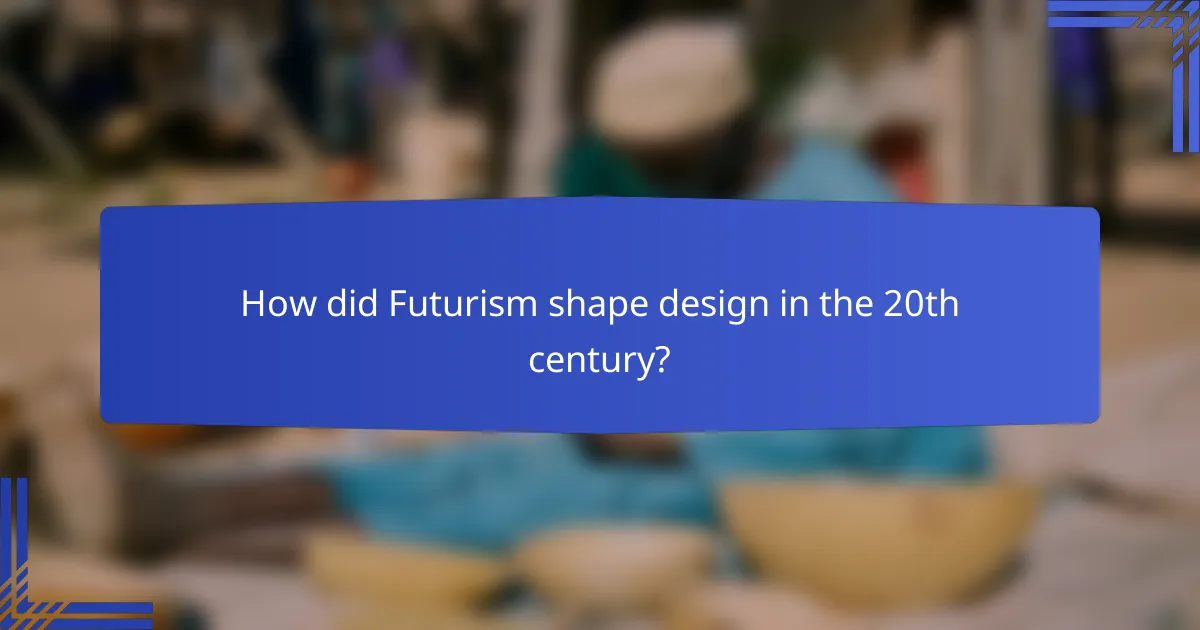
How did Futurism shape design in the 20th century?
Futurism significantly influenced design in the 20th century by emphasizing speed, technology, and modernity. This movement inspired a break from traditional aesthetics, leading to innovative approaches in various design fields.
Influence on architecture
Futurism’s impact on architecture was marked by a focus on dynamic forms and the integration of modern materials. Architects began to experiment with concrete, glass, and steel, creating structures that conveyed movement and energy.
Notable examples include the work of Italian architect Antonio Sant’Elia, whose designs featured bold lines and futuristic concepts. The use of asymmetry and unconventional shapes became a hallmark of Futurist architecture, reflecting the rapid changes of the industrial age.
Impact on graphic design
In graphic design, Futurism introduced a vibrant visual language characterized by bold typography and dynamic compositions. Designers sought to capture the essence of speed and motion through the use of diagonal lines and fragmented forms.
Futurist posters, such as those created by Fortunato Depero, showcased bright colors and innovative layouts that broke away from traditional design norms. This approach not only influenced advertising but also laid the groundwork for modern graphic design practices that prioritize visual impact and clarity.

What are the major figures in the Futurism movement?
The Futurism movement, which emerged in the early 20th century, is characterized by its celebration of technology, speed, and modernity. Key figures in this movement include Filippo Tommaso Marinetti and Umberto Boccioni, who played significant roles in defining its principles and artistic expressions.
Filippo Tommaso Marinetti
Filippo Tommaso Marinetti is often regarded as the founder of the Futurism movement. In 1909, he published the Futurist Manifesto, which called for the rejection of the past and the embrace of modern technology and speed. Marinetti’s writings emphasized the beauty of machines and the dynamism of contemporary life.
His work not only influenced literature but also impacted visual arts and music. Marinetti’s vision encouraged artists to explore new forms and techniques that reflected the energy of the modern world, often using bold colors and abstract shapes to convey movement.
Umberto Boccioni
Umberto Boccioni was a pivotal figure in the visual arts aspect of the Futurism movement. He is best known for his sculptures and paintings that captured the essence of speed and movement. Boccioni’s work aimed to depict the dynamic qualities of life, often merging figures with their surroundings to create a sense of continuity and flow.
His notable works, such as “Unique Forms of Continuity in Space,” showcase his innovative approach to form and structure. Boccioni’s contributions helped establish Futurism as a significant force in early 20th-century art, influencing later movements like abstract art and modernism.
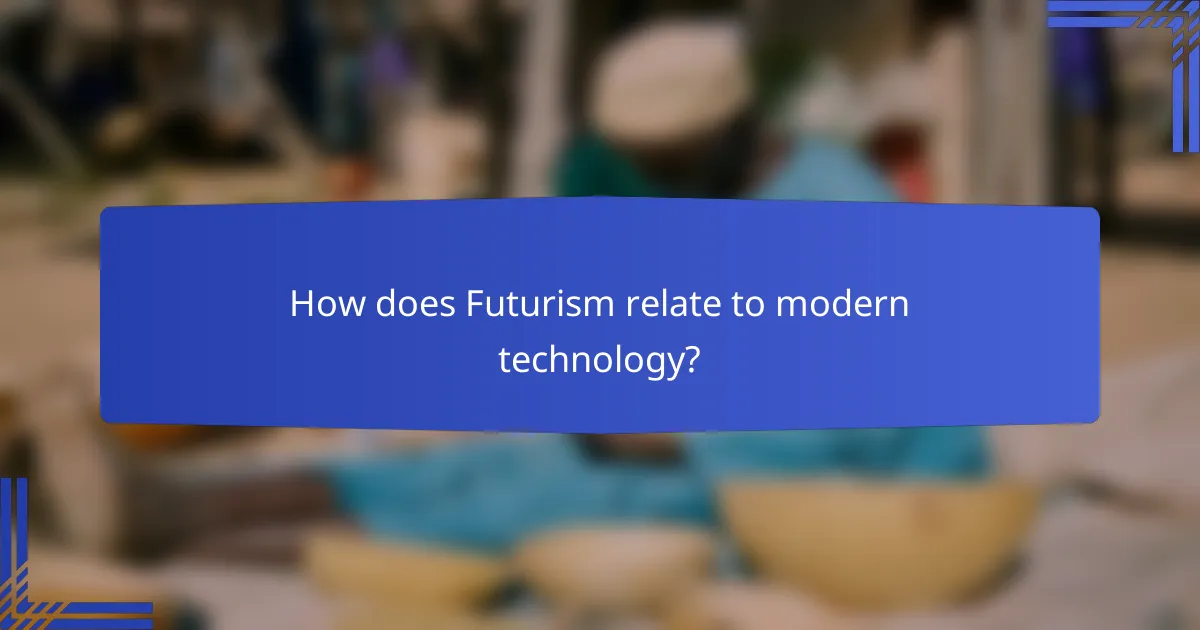
How does Futurism relate to modern technology?
Futurism is intrinsically linked to modern technology through its celebration of speed, innovation, and the dynamic nature of contemporary life. This movement emphasizes the transformative power of technology, influencing various artistic and cultural expressions that reflect the rapid advancements in society.
Connection to digital art
The connection between Futurism and digital art is evident in the way both embrace technology as a medium for creative expression. Digital artists often draw inspiration from Futurist principles, incorporating themes of movement and modernity into their work. For instance, animations and interactive installations can evoke the same sense of speed and energy that Futurism champions.
Moreover, digital platforms allow for the exploration of new techniques and styles that align with Futurist ideals. Artists can experiment with virtual environments, creating immersive experiences that reflect the fast-paced nature of modern life.
Influence on virtual reality
Futurism’s influence on virtual reality (VR) is significant, as both focus on the experience of speed and the redefinition of space. VR technology enables users to engage with environments that mimic the Futurist fascination with movement and the future. This creates opportunities for users to experience art and narratives in ways that traditional media cannot offer.
As VR continues to evolve, it incorporates elements of Futurism by allowing for rapid changes in perspective and interaction. Developers can create simulations that reflect the chaos and excitement of urban life, aligning closely with the Futurist vision of a technologically advanced future.

What are the criticisms of Futurism?
Critics of Futurism often highlight its glorification of violence, nationalism, and its problematic stance on technology and modernity. These elements raise ethical concerns about the movement’s impact on society and culture.
Political implications
The political implications of Futurism are significant, as the movement was closely associated with fascist ideologies, particularly in Italy during the early 20th century. This connection raises questions about the role of art in promoting authoritarianism and militarism.
Futurism’s emphasis on action and aggression can be seen as a call to arms, which some argue contributed to the rise of totalitarian regimes. The movement’s rejection of traditional values in favor of a radical future often aligned with nationalist sentiments, complicating its legacy.
Gender representation issues
Futurism has been criticized for its portrayal of gender, particularly its objectification of women. The movement often depicted women as symbols of beauty and speed, reinforcing traditional gender roles rather than challenging them.
Moreover, the male-centric narratives within Futurism marginalized female voices and contributions. This lack of representation raises broader questions about inclusivity in modernist movements and the need for diverse perspectives in discussions of progress and modernity.
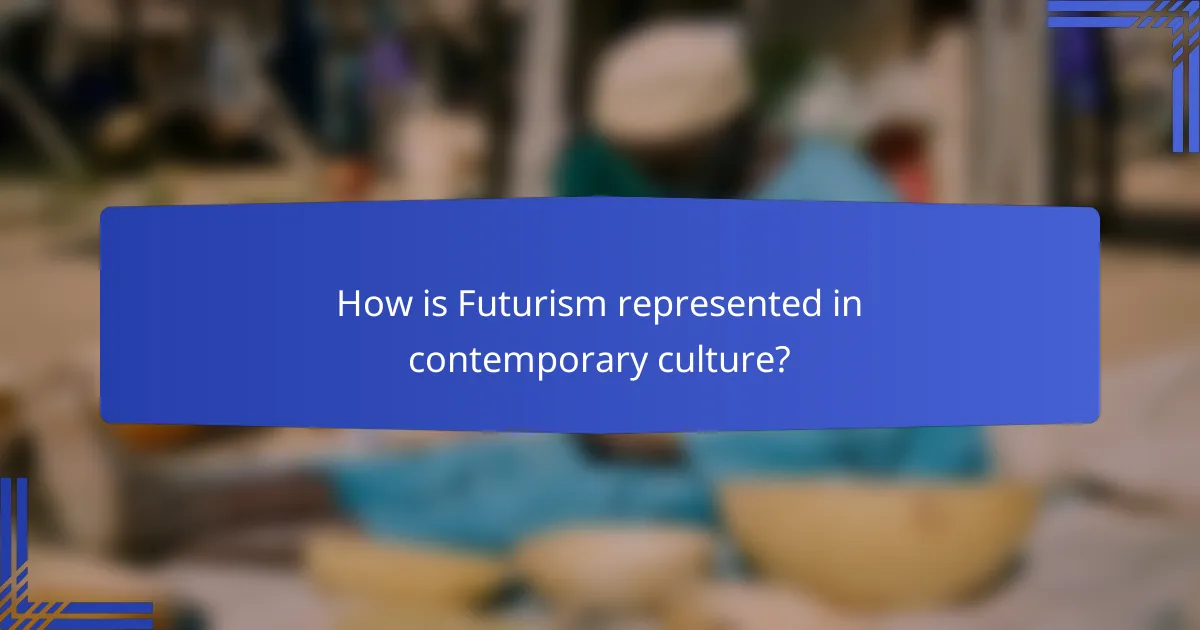
How is Futurism represented in contemporary culture?
Futurism is represented in contemporary culture through various mediums, including art, literature, and design, emphasizing speed, technology, and modernity. Its influence can be seen in the aesthetics of urban life, digital art, and even fashion, reflecting a fascination with progress and innovation.
Films inspired by Futurism
Futurism has significantly influenced cinema, particularly in how filmmakers portray speed, technology, and urban landscapes. Movies often incorporate dynamic visuals and themes of progress, echoing the Futurist movement’s core ideals.
Examples of films inspired by Futurism include “Metropolis,” which showcases a futuristic cityscape and explores themes of industrialization, and “Blade Runner,” which presents a dystopian future filled with advanced technology. These films highlight the tension between humanity and machinery, a central concern of the Futurist ethos.
When analyzing Futurist influences in film, consider how visual techniques such as rapid editing, sweeping camera movements, and vibrant color palettes convey a sense of speed and modernity. These elements not only enhance the storytelling but also immerse viewers in the Futurist vision of the future.
